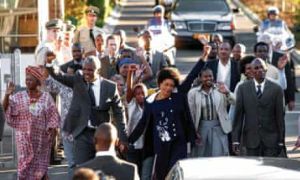Mandela: Long Walk to Freedom (2013)
Mandela: Long Walk to Freedom was released on December 25, 2013, in the USA. The American Drama film was produced by Videovision Entertainment. The movie storyline was written by William Nicholson, and directed by Justin Chadwick. The movie was based on the autobiography of Nelson Mandela, which was written in 1995[1].
Plot

Nelson Mandela (Idris Elba) was born in Xhosa Village. In early 1940, he becomes a lawyer for defending domestic servants. He joins the African National Congress (ANC) as he is raged for the racial policy of South Africa, the apartheid. He goes all out against the government, becoming a militant, burns his identity paper, and moves to every safe house ANC has. Nelson Mandela and the members of the ANC are arrested for treason as the government labeled them Communists. The marriage of Nelson Mandela breaks apart and marries another woman, Winnie (Naomie Harris). Mandela and the ANC members are said to be not guilty during the trial. After that, he decides to change the strategy into a guerilla strategy where they sabotage against government installations. Then, Mandela is captured and sentenced to life imprisonment in Robben Island. After 27 years in prison, Mandela is released and came back as a politician who later on, becoming the first black President of South Africa[3].
Black Empowerment
The movie portrays how Nelson Mandela opposes the apartheid, the racist policies in South Africa, in various ways. At first, he fights with an all-out war with the government by doing militants and sabotages all government establishments and machinery. He says clearly to the government "We no longer accept the authority of a state that wages war on its own people," just before the police arrested him. However, after his life in prison, Mandela changes his strategy in fighting racism through nobility and peace. He becomes a president and preaches forgiveness to all black South African people in order to obtain reconciliation to both sides of races in South Africa[4].
References
- ↑ https://www.imdb.com/title/tt2304771/?ref_=nv_sr_srsg_3
- ↑ https://i.guim.co.uk/img/static/sys-images/Guardian/About/General/2013/12/30/1388420817223/Mandela-Long-Walk-to-Free-011.jpg?width=445&quality=45&auto=format&fit=max&dpr=2&s=c101ad645ccb028234c27b2a07e5bd90
- ↑ https://www.spiritualityandpractice.com/films/reviews/view/25689/mandela-long-walk-to-freedom
- ↑ https://www.theguardian.com/film/2014/jan/05/mandela-long-walk-to-freedom-review